
Filthy India Photos, Chinese Netizen Reactions

Note from Fauna: The following post and collection of photographs spread on the Chinese internet in 2008.
Reflections in the midst of extreme poverty and filth — a record of a trip in India
India is the dirtiest country I have ever been to. I have heard people say that Pakistan, which is to the west and Bangladesh, to the east, are worse, but that is probably beyond the limits of my imagination.
In two months in India, I went from south to north, visiting some tourist towns that I had read about. I also went by train and bus to countless towns and open fields that weren’t so famous, and everywhere there were people had something in common — dirty, messy and stank. Interestingly, I also saw countless foreigners having a great time.
Tourists have been coming for years to the small town of Bodhgaya , the place where 2500 years ago Buddha achieved enlightenment, bringing their foreign money to the pockets of a few hotels and tourism operators, but still they live in abject poverty. The streets are lined with rubbish, wild animals squabble to find their breakfast in it. Look carefully and find wild pigs, dogs, mountain goats, and sometimes even cows, which are considered sacred, make an appearance. No wonder the locals don’t each much meat, these animals depend on trash to survive.
Cow dung is the most environmentally friendly fuel source
India is very dry, and vegetation scarce. Sometimes you’ll sweep your eyes over the horizon and only see a barren expanse. Rural villagers use firewood, but like using cow dung more. In cities and towns, sacred cows fill the streets, defecating wherever they please. Cow dung is the most eco-friendly kindling of all, and this means less trees need to be cut down. Moreover if the manure that is produced is not removed daily, a small town would probably quickly drown in it.
You often see see women collecting fresh manure, packing it together with hay using both hands, then carefully sticking it against a wall to dry. The manure largely contains grass that the sacred cows are unable to digest. For Indians, this kind of smell is natural, and tourists who have stayed awhile get used to it. In my two months in India, I learned to accept the piles of cow dung that fill the streets, and their all pervading odor. Compared with the smell of the dung of carnivores, the smell isn’t as strong. Indians have an undying reverence for their sacred cows, which makes me automatically think of people in the modern age and their frivolous materialism.
Puri is a tourist hot spot on the east coast, where heaven and hell come together. One side of town is the hotel area, with its picturesque beaches, the other side is a poor fishing village. The inhabitants’ straw huts are lonely islands in a sea of trash, and I got the feeling that it’s never taken away. The most shocking thing: every villager would defecate on the beach. It wasn’t only villagers who would take a crap on the beach, out in the suburbs you’d get used to seeing people doing it on the side of the road, and the Indian men would do it out in the open, never sneaking off to a secluded spot in the undergrowth. Everywhere from small towns to large cities would have men showing the special characteristics of their culture; even in the major city of Kolkata [Culcutta], on the most upmarket of streets, were white collar workers carrying briefcases walking past crowds of people urinating against walls.
One can’t criticise people for reliving themselves on the beach or in a field, after all this is what our ancestors had to do, all the Indians are doing is preserving a natural way of life that has continued for tens of thousands of years. This is one of the most natural parts of the way people there live, and it’s only we foreigners who make a fuss about it. It’s just that urinating on the street in a big city after all isn’t very decent, but I am sure that with the increasing pace of modernization, India’s cities will very quickly take on a new look. China’s toilet usage/habits have come a long way in the past ten years, so is there any reason that India, another ancient Eastern civilisation, can’t do the same?
I am filthy, but I am brilliant. In the ancient city of Varanasi [Benares], on the banks of the Ganges, all the sewage created by people relieving themselves on the ground in corners, and the rubbish, everything flows into that sacred river, the same water where pilgrims come from all over, brushing their teeth, washing their faces, bodies, and swimming. However, the dirty Ganges and Varanasi are India’s most beautiful place, lots of foreigners love it, staying for months at a time. I lived there for a while, living like a local, swimming in the river like one of them. The ancient town’s intense artistic spirit and religious fervour made me forget material poverty. This important part of the Indian psyche is passed down even today: the spirit is greater than physical riches.
India is indeed “dirty”, “messy” and “smelly” but I have gotten more out of it than any other place I have been. If this wasn’t the case in my two months I wouldn’t have met so many expats who return often, or never leave. As the Taiwanese dancer Lin Huaimin said, whenever he is stuck for artistic inspiration, he goes back to India.
Maybe only in the most disgusting of material surroundings, and the basest living conditions can we find the most profound spiritual enlightenment.
[Warning: This post contains graphic images.]
[Note from Fauna: Not every copy of the post includes the same captions or all of the same pictures. We have translated from the Liu Liu version of the post, which appeared later than the Tianya and Mop copies. ]
Puri, where heaven and hell come together.
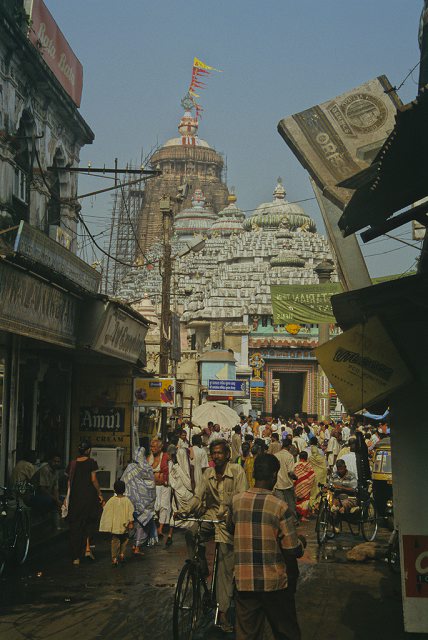
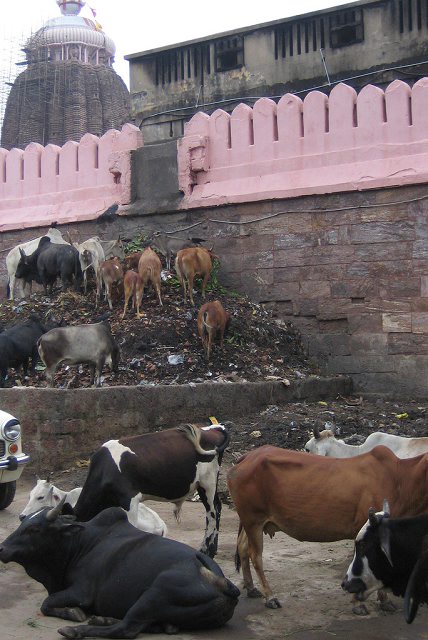
The banks of the Ganges River, and women laying out cow dung to dry.
The famous ancient city of Varanasi. The Ganges is for both morning baths and cremations.
At the river side lighting the fire for cremation.
Floating corpses, a common sight on the Ganges!
Here come the remains of a sacred cow!
The famous morning bathing by the Ganges, washing as if the rotting corpse floating by was nothing!
Bathing in the corpse-filled Ganges!
A corpse in the midst of the morning bathing at the Ganges, what do you think?
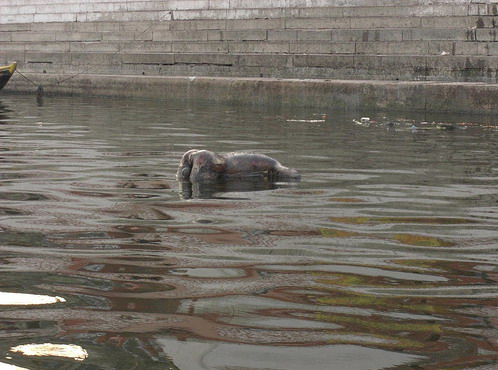
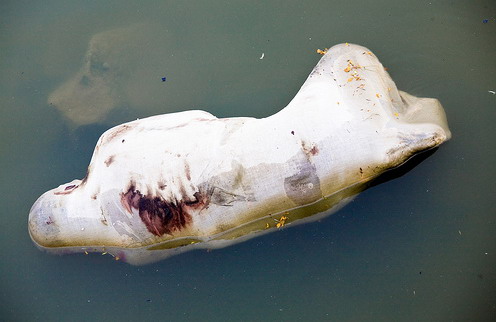
Corpses…as if they were nothing…sigh!
A rotting body on the banks of the Ganges River.
A body floating by a wharf. Gasp!
A floating rotten corpse.
The floating corpse of a sacred cow!
The body of a cow or a sheep?
Ganges River scenery.
Everywhere the floating corpses of sacred cows!
Natural clothes washing area + sun drying clothes area + cow and sheep bathing pool + excrement flowing and mixing together.
Ganges River morning bathing, how can this water be used for brushing teeth?
Bodies abandoned at the Ganges River.
A dead elderly man by the Ganges River.
A body being dragged by a boat.
Note the lower right corner. What is it? Revealed in the next photo.
Here comes the close-up!!!! Note the flies!!!!
Washing after discarding a corpse.
An old man also comes to bathe.
Girls also come to bathe.
Those on the shore bathe, while in the water floats a stinking bloated corpse.
A skeleton on the shore of the Ganges River.
A corpse floating in the Ganges River.
Let’s put the corpses-in-the-Ganges-River aside for a moment, and talk about Indians using the toilet. Have a look at the three pictures below…
These three toilet photographs represent three levels of toilets in India. Note what is common to all of them, which is that none of them have any toilet paper, but all of them have a bucket of water at arms length… yes, you’ve guessed correctly, Indians don’t use toilet paper when using the toilet, they use their hands. After defecating, you use your left hand finger to wipe the feces around your anus, and then use the water in the bucket to wash your hand. The custom is to use your left hand to wipe your butt, so when you go into a store to select food, you mustn’t use your left hand.
JY people believe, this is actually is a good habit. The first benefit is that cases of hemorrhoids are significantly lower; the second is that it can greatly save paper, good for protecting the earth’s resources and the development of green initiatives. So just by doing this, it saves a great amount of wood.
I’m not sure if I should bring out this photo…a sick elderly person, lonely standing by the Ganges River. I don’t know if he is appreciating the true meaning of life or bemoaning the helplessness of human existence…that helpless expression…that remarkable face carved by the years…is unforgettable…
Don’t look if you won’t like it…you are responsible for yourself…
Sunset, rotting corpse, rowing and enjoying the beautiful scenery.
Sunset, rotting corpse, a butt facing the sky.
A rotting corpse in the Ganges at dusk.
A rotting corpse that looks like a frog.

A person more frightening than the rotting corpses and old leper! Seems to be someone who carries dead bodies professionally.
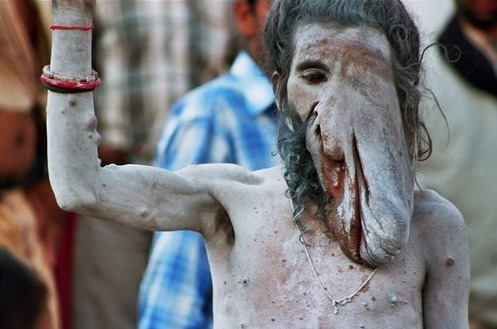
The Ganges River filled with rotting floating corpses, and people rowing boats as if nothing were the matter.
Not only do [they] wash and bathe in the Ganges River where rotting corpses float about, [they] also drink from it. My god, I can’t take it anymore!
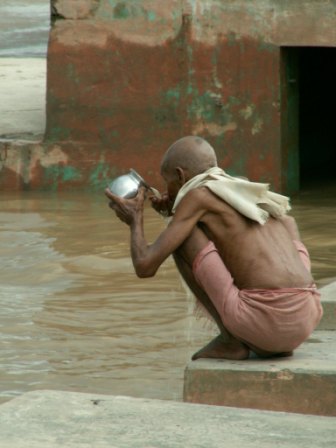
Rotting corpse on the shore.
Wild dogs freely tearing their food off a rotting corpse.
Wild dogs tearing their food off the rotting corpse of a sacred cow.
A crow standing on a floating rotting corpse.
Corpses on the Ganges River, giving off an offensive rotting stench.
Dog. Crows. Fighting for a child’s head as food. Dog victorious.
Dog gnawing on human head.
Steps on the river shore with floating corpses. Can you tell how many rotting corpses are in the water?
An old fish catcher on the shore of the Ganges River.
The tour guide said that this kind of fish in the Ganges is called “Gulang” fish, a very nice sounding name…and it is said the flavor is very good, but upon thinking of the corpses soaking in the water, the soap from the bathing, the garbage by the river…I don’t have the courage to try it, not sure if this kind of fish will have a human flesh flavor…
This needs no introduction as many compatriots are able to eat it domestically [in China]…but a reminder, never eat an authentic one…because the chef uses his left hand to wipe his shit when using the toilet/restroom.
Here, let’s let the JY people see India’s free medical care.
A public hospital’s surgery room.
Ganges River in the early morning, bustling because of the crowds…some to wipe themselves down, some to get water, some to bathe.
Suddenly encountering some familiar faces, [I] was surprised…deeply admiring the guy who entered the water to his waist…BH [biao han, daring] to the extreme…but hope he is not our compatriot.
Flagrantly floating downstream not 500 meters at another set of steps [into the river] was a corpse. Even foreigners had taken out their cameras to snap photos. I wonder how that swimming guy just mentioned above felt…
Two photographs after going ashore…
An elderly person doing morning exercises, technical difficulty rating 3.0, far higher than the Tai-chi exercises of old men and women in [China's] parks.
Accepting a holy water baptism…valiantly emerging from the water…[his] motions toofucking carefree…
Not enough money to buy [enough] firewood, those two feed will not be able to burn away, so it looks like they can only be discarded into the Ganges River…the people baptizing [in the Ganges], will they be so daring as to find a foot…?
Now let’s return to this post’s main topic…the rotting corpses in the Ganges River.
What are the dogs eating? Notice what is in the water on the left side of the image!
Swimming and bathing even with so many rotting corpses around.
There are a small number of middle-aged men and women squatting on the steps brushing their teeth, none of them using toothbrushes, half of them using their fingers, the other half using twigs, swallowing the water after brushing, and then cupping and drinking down a few more gulps, which happens to be in the opposite direction of people in other countries brushing their teeth and then spitting the water out.





























































































